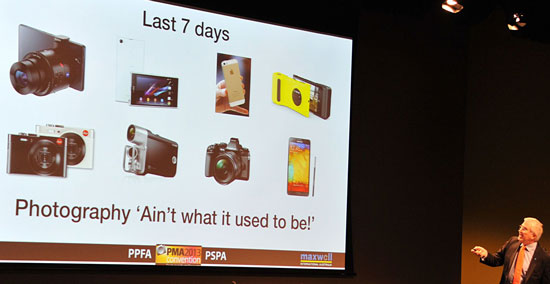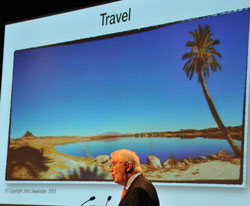John Swainston, managing director of Maxwell International Australia, distributors of Tamron, Lowepro and other leading photo brands, joined Gary Lamb, GfK Australia’s head of retail in the opening session of the PMA Convention in Melbourne last month. Here, John lists some of the core changes affecting photo retail today:

John Swainston opened his talk by listing eight imaging products launched at the IFA trade exhibition in Berlin in September that shared a common feature: All – Sony QX10/100, Sony Xperia Z1; Apple iPhone 5C and S; Nokia Lumia 1020; Leica C; Sony Wi-Fi MVR; Olympus OMD-E-M1; and Samsung Galaxy Note 3 featured built-in Wi-Fi, all with 1080p video capability.
Mr Swainston called this change in a core feature set a catalyst for change, noting that Wi-Fi now featured in 30 percent of the top-selling compact cameras, and was growing fast. So his first challenge to the audience was to ask how many stores offered Wi-Fi to their customers in store, so that mobile shopping was easier, and rapid access to QR code info on many products in store enabled quick and correct information to be accessed without the need of a 3G or 4G phone connection.
The response from the audience indicated that quite a few retailers hadn’t made the move to in-house Wi-Fi, with some retailers after the presentation expressing concern that they would be simply encouraging potential customers to price match in an environment where it was difficult to be price competitive with larger players.

Mr Swainston used 20 and 10-year old data to make clear that despite the recent fall in unit volumes and average selling prices in hardware, the compact point & shoot camera segment today is still 2.5 times larger than it was in 2003, and interchangeable lens cameras – DSLRs and mirrorless – were 3.5 times the volume. So ‘the good old days’ he said, were not as good as they seemed, and our industry is still selling nearly 15 percent of homes a new dedicated camera, more than double the long-term average in film days.
The next area reviewed was the five-year value of a customer: Compared to 20 years ago, the revenue increase was some 50 percent, but margins had grown by only 37 percent, while costs had more than doubled.
In other words, while revenue has grown 50 percent, the rate at which margin has increased in dollars has not kept up, meaning margins are now much lower than a decade ago. This, he argued, was largely because of the loss of printing margins.
‘While hardware margins have fallen considerably, the real impact that’s proved too much for many smaller business operators was the loss of the print business model of 65-percent-plus margins.’
This, above all, was the primary reason that retailers were doing it tough today in photo, he continued. Along with this was a reduction in store visits; there were no longer eight guaranteed visits to process and pick-up the family average of four rolls of film.
The loss of the high margin printing and processing business from the ’80s and ’90s minilab boom was the key change impacting retailers today, said Mr Swainston, in combination with accelerated labour cost increases and high rents compared to many overseas GST-free sources.
He then reviewed some key conclusions from the PICA (now IDEA) industry research carried out at the end of the film era. The core behaviours in photography in the ’90s were driven by events, and key ‘special’ moments in life’s journey: babies; birthdays; seasonal events like Christmas; travel; family gatherings; and kids’ key milestones – first day at school, school play, sports carnivals, etc. And each time someone wanted to see those pictures, prints were required, many of which were thrown away, and the majority stored in the shoebox.
Today, John said, photo behaviours are dominated by the ubiquitous smartphone, used by 60 percent of phone owners. Today every day is a Photo Day. The previous inhibitions limiting photography are gone, because a camera is available 100 percent of the time.
(Consumer research by Kodak towards the end of the film era showed that the single most nominated reason more photos weren’t being taken was the absence of an available camera.)

In addition overseas trips have risen from 2.5 million to over 8 million a year, in part encouraged by the high Australian dollar. But social media had driven up exposures per year from 120 per person to well over 450 a person with a phone.
Storage in physical photo albums had given way to ‘the cloud’, (with the computer hard disk as perhaps the virtual shoebox), and sharing had replaced memories as a motive to print.
Facebook’s 350 million new pictures a day dwarfed historic photo volumes. The key was to find a way to make money from this increased picture-taking behaviour, central to which is encouraging picture-takers to add value to their photographic activity through printing in photo books and other new media such as canvas and gifting.
In the final part of his talk Mr Swainston addressed changed retail buying patterns, internet shopping growth and the 24/7 demand for facts and instant sales gratification. He reinforced some of the trends included in Gary Lamb’s earlier presentation about value change, retailer concentration worldwide, and the shift to services from physical goods that was an overarching part of the modern retail consumption pattern.
John Swainston concluded by nominating three features which retailers might focus on to attract consumers: the presentation of strong images with power and emotive strength, well displayed in-store to inspire and reinforce the core benefits of owning a specialised camera; new print services available in store; and connectivity. He identified people, new babies, events, travel, creative expression (generated by the Instagram generation), and memories as core subject matters that will continue to be strong for generations to come.
As a 42-year veteran of the photo industry, he expressed confidence that retailers who embraced the potential of the new changes would still be able to grow and prosper. While such journeys were tough, painful and expensive, the future was potentially brighter than ever for those that make the journey.
(Thanks to John Swainston for assistance in preparing this feature.)





Be First to Comment